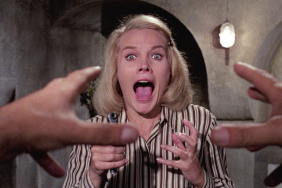
In 1973, after prolific director Sergio Martino made three formative giallo films The Strange Vice of Mrs. Wardh, All the Colors of the Dark, and Your Vice Is a Locked Room and Only I Have the Key the filmmaker created a giallo-slasher hybrid that conflated sex, violence, and art. Torso was released a decade before Dario Argentos Tenebre, but like the subversive thriller, Martinos movie shares similar self-reflexive moments on the matter. He was a painter, not a butcher, says one of the college students in Torso as she lectures a classmate about Pietro Peruginos Saint Sebastion portrait. She could have easily been talking about Martino, whose visually striking and visceral movies have posited him as artist and mere craftsman alike.
Unlike the youthful saint, usually depicted bound and pierced by arrows but still pure, the campus setting in Torso is a hub of feverish sexuality where classroom glances escalate to drugged-out orgies in abandoned buildings (parodying the sexually liberated generation, a theme throughout the film). Set against a series of murders in the university town of Perugia, Torso establishes its grimy sexuality in the opening of the film. An unseen photographer captures bizarre, voyeuristic snapshots of group sex participants fondling an old porcelain doll. Later, during the films nastiest stalk-and-slash sequence, a topless coed wanders into a woodland swamp where shes assaulted. The fiend massages the mud into her naked skin. He completes the violation by penetrating her eye sockets with his fingers, something we see exacted on the doll in the beginning of the movie, in a symbolic act of sexual violence. Torsos murderer is the doll as fetish object brought to life his frightening mask possesses a series of crude holes, reflecting his views on women whom he later denounces as bitches.
But its not just the killer who views the coeds of Perugia as stupid dolls. When a group of the universitys women retreat from the killings to a nearby village, they create a scene amongst the working-class denizens. Perched atop a tractor as they shop in the village square, their poses mirroring the historical artworks we witnessed them studying earlier, the local men gawk and make lewd remarks about their bodies. The focus during the scene is on African-American character Ursula, played by Carla Brait (The Case of the Bloody Iris). In repose before the crowd, shes an object of fascination not only because of her femininity, but because of her skin color. Theyre all the same in the dark, one man spews to an onlooker. Hes referring to women in general, but the racial implications are clear.
I dont think that the girls are politically aware, another man later declares. This hints at the crux of a real-life issues plaguing Italy at the time. A wave of class, gender, and political struggles in the late 60s carried into the 70s, inciting strikes and occupations that often found workers and students joining forces. Many students were workers as well, inspired to further their schooling due to changing education laws that prompted a sudden influx of university enrollment leading up to the unrest. But within the groups were factions where tensions mounted due to opposing provincial, political, and progressive stances on gender, social, and economic equality. Martino and frequent co-writer Ernesto Gastaldi use Torsos university and village populations to magnify the issues through satire and savagery.
Torsos focus on repressed sexuality, centered on a killer whose childhood trauma has twisted his psychosexual mind, influenced the hormonal American slasher genre. Like those later films, Torso takes place in a secluded setting, transformed into a charnel house. The film champions a final girl who confronts the killer in a tense stand-off, captured by Giancarlo Ferrandos voyeuristic cinematography, and features a moralizing villain who indulges in visceral thrills. Pamela Voorhees punishes sexually active teenagers for the death of her son Jason in Friday the 13th, just as Torsos antagonist systematically slaughters liberated coeds who are both immoral and enticing to him. This makes him feel shame, which can only be dispelled with murder. Death is the best keeper of secrets, the killer hisses. But unlike the dolls whose gaze he tries to vanquish, deaths eternal gaze is inescapable.
—
Alison Nastasi is a giallo addict and the weekend editor of Flavorwire. You can find her talking about exploitation cinema, VHS, occult oddities, Hammer horror, and other genre fare on Twitter.









